Social and Economic Aspects of Sustainable Development of Livestock Production and Meat Consumption in the Czech Republic
Abstract
1. Introduction
2. Materials and Methods
2.1. Methodology
- an evaluation of statistical data published by the Czech Statistical Office (CZSO) on the production of the individual meat types in the Czech Republic in the period 2000-2019;
- an evaluation of statistical data published by the Czech Statistical Office (CZSO) on the consumption of the individual meat types in the Czech Republic in the period 2000–2018;
- identification of factors threatening the sustainable development of livestock production and meat consumption;
- an assessment of the incentive factors that will lead to a growing interest of Czech farmers in increasing the production of meat and meat products;
- a description of the necessary legislative changes by the state that would allow sustainability or possibly an increase in the share of the local production of meat and meat products for the consumption of households in the Czech Republic.
2.2. Performance of Czech Agriculture
3. Results
3.1. Meat Production in the Czech Republic
3.1.1. Pig Meat Production
- 283,787 tons of pig meat were imported into the Czech Republic in 2017;
- 35,598 tons of pig meat were exported, in particular to Slovakia.
3.1.2. Beef and Veal Meat Production
- the total amount of beef imported from abroad was 37,283 tons;
- the total amount of beef exported abroad was 10,322 tons.
3.1.3. Poultry Meat Production
3.1.4. Sheep and Goat Meat Production
3.1.5. Relationship between Pork, Beef and Poultry Production
3.2. Meat Consumption in the Czech Republic
3.2.1. Share of Meat Consumption in the Czech Republic
3.2.2. Share of Individual Types of Meat in Its Total Consumption
3.3. Changes in Meat Consumption in the Czech Republic
- (a)
- The impact of BSE (Bovine spongiform encephalopathy) disease in cattle is overestimated;
- (b)
- the quality of the beef offered is relatively low, but above all unreliable, non-standard. In this sense, beef loses in competition with pork and poultry;
- (c)
- the consumer appreciation of the “quality-price” relationship is worse for beef than for the other two main types of meat. Chicken meat is the best from this comparison;
- (d)
- on the market, beef from older pieces is exchanged for younger meat. Such an experience will discourage consumers from the next interest in beef;
- (e)
- economic reasons (lack of refrigeration capacity, weight loss during cold storage of meat) lead to premature dispatch of meat and thus to its insufficient maturation and failure to achieve the expected culinary and sensory quality.
3.4. Statistical Forecast of Meat Consumption in the Czech Republic
3.4.1. Prediction of Pork Consumption
3.4.2. Prediction of Beef Consumption
3.4.3. Prediction of Poultry Meat Consumption
4. Discussion
4.1. Possible Trends in Meat Consumption and Their Impact on the Sustainability of Its Production
4.1.1. Healthy and Rational Nutrition
4.1.2. Vegetarianism and Veganism
4.1.3. Food Supplements
4.1.4. Ethical Reasons for Reducing Meat Consumption
4.2. Evaluating the Validity of the Hypothesis and Results of the Analysis
- Meat production in the Czech Republic increased slightly by 0.4% year-on-year 2019/2018 to 450.8 thousand tons. The total consumption of meat in the Czech Republic shows stable values, which according to the prediction should continue (until 2024 it would change only by +0.1 kg/person/year). There is therefore no contradiction between future production and consumption.
- Pork meat production in the Czech Republic has seen a significant declining trend since 2004 and reached its minimum in 2019. On the contrary, pork consumption shows a growing trend in the future. By 2024, pork consumption should increase by 0.61 kg/person/year, i.e., by 1.4%. This enables the sustainable development of pork meat production in the Czech Republic and, given the low self-sufficiency in its production (approximately 51%), it gives Czech farmers the prospect of secure sales.
- Beef and veal production in 2019 increased by 1.8% year-on-year. The lowest production was in 2014. However, the consumption of this type of meat in the Czech Republic has also increased slightly since 2013, and according to the prediction calculated by Holt’s model, it should be stable by 2024 and be around 8.66 kg/person/year. However, beef is too expensive for today’s households in the Czech Republic and difficult to cook. This limits the sustainable development of its production, which is further complicated by insufficient use of processing capacities (due to labor shortages), insufficient demand (self-sufficiency of around 140%) and achieving better prices for producers by exporting live cattle to foreign markets. Moreover, beef is considered a very pollutant food, mainly regarding greenhouse gas (GHG) or global warming potential (GWP) [12].
- In 2019, the Czech Republic produced more poultry meat by 1.02% year-on-year. Production has been increasing every year since 2013, but poultry farming is a marginal issue for Czech primary producers. Consumption of poultry meat in the Czech Republic has been increasing since 2013 and, according to the forecast, should continue to grow. In 2024, it could increase by 4.4% compared to 2020. The main exporter of poultry meat to the Czech Republic is Poland. Poultry meat is considered healthy by consumers. However, the sustainable development of poultry meat production and consumption is significantly influenced by the EU directive on the abolition of cage farming, which in turn will allow for better animal welfare, but may generally lead to more expensive production of poultry meat and eggs. On the other hand, for many people, this can lead to greater confidence in the quality of poultry meat, including support for the ethical aspects of the matter.
4.3. Recommendations for Government and Practice
- The first step that should be taken to improve the situation in Czech agriculture in the production of pig meat is to restrict imports of animal products at dumping prices from Poland and Germany, for example.
- Expansion of the currently insufficient processing capacities. For many years, the Czech Republic has thus been exporting unprocessed commodities such as milk and cattle and importing final products such as pig meat and cheeses.
- The unification of support for farmers in the European Union to ensure a level playing field for their businesses would have significant impact as well.
- Support for farmers that are associated through the formation of sales cooperatives should be increased as well. They could have both tax reliefs and, for example, be given precedence in grant programs; another option would be to waive their social and health insurance payment obligations.
- The state should also improve the conditions for receiving foreign workers, who could be employed seasonally in both livestock and crop production in agriculture.
5. Conclusions
- Pork consumption shows a growing trend in the future. However, this aspect runs into nutritional recommendations and is related to the high incidence of obesity and diabetes in the Czech population. The Czech Republic’s nutrition policy still draws attention to the need to limit the consumption of traditional pork and the possibility of replacing it with fish and game.
- Beef is too expensive for today’s households and difficult to cook. Its future consumption calculated by Holt’s model is constant and should be around 8.66 kg/person/year.
- Poultry meat is considered healthy by consumers. Its consumption should continue to increase, and the model shows that in 2024 it could reach the level of 30.13 kg/person/year.
Author Contributions
Funding
Institutional Review Board Statement
Informed Consent Statement
Data Availability Statement
Conflicts of Interest
References
- Marunelu, I. Research on the Small Peasant Individual Households in Romania within the Framework of Sustainable Agriculture. Sci. Pap. Ser. Manag. Econ. Eng. Agric. Rural Dev. 2020, 20, 341–346. [Google Scholar]
- Lv, Y.; Zhang, C.; Ma, J.; Yun, W.J.; Gao, L.L.; Li, P.S. Sustainability Assessment of Smallholder Farmland Systems: Healthy Farmland System Assessment Framework. Sustainability 2019, 11, 4525. [Google Scholar] [CrossRef]
- Brohm, K.A.; Klein, S. The Concept of Climate Smart Agriculture—A Classification in Sustainable Theories. Int. J. Qual. Res. 2020, 14, 291–302. [Google Scholar] [CrossRef]
- European Commission. EU Approach to Sustainable Development. Available online: https://ec.europa.eu/info/strategy/international-strategies/sustainable-development-goals/eu-approach-sustainable-development_en (accessed on 16 December 2020).
- Prus, P. Sustainable Farming Production and Its Impact on the Natural Environment—Case Study Based on a Selected Group of Farmers. In 8th International Scientific Conference on Rural Development—Bioeconomy Challenges. Proceedings of the 8th International Scientific Conference on Rural Development—Bioeconomy Challenges, Akademija, Lithuania, 23–24 November 2017; Raupeliene, A., Ed.; Aleksandras Stulginskis University: Akademija, Lithuania, 2017; pp. 1280–1285. [Google Scholar]
- Kowalska, M.; Knapik, W.; Bogusz, M. Zrównoważony rozwój obszarów wiejskich. Probl. Ekorozw. 2016, 11, 81–88. [Google Scholar]
- Silva, C.L.M.; Costa, R.; Pittia, P. Responsible research and innovation in the food value chain. J. Food Eng. 2017, 213, 1. [Google Scholar] [CrossRef]
- Wesana, J.; de Steur, H.; Dora, M.K.; Mutenyo, E.; Muyama, L.; Gellynck, X. Towards nutrition sensitive agriculture. Actor readiness to reduce food and nutrient losses or wastes along the dairy value chain in Uganda. J. Clean. Prod. 2018, 182, 46–56. [Google Scholar] [CrossRef]
- Mathias, J.F.C.M. Manure as a Resource: Livestock Waste Management from Anaerobic Digestion, Opportunities and Challenges for Brazil. Int. Food Agribus. Manag. Rev. 2014, 17, 87–109. [Google Scholar]
- Kašparová, K.; Svoboda, R.; Severová, L.; Hinke, J. Evaluation of the performance of Czech agriculture. Indian J. Agric. Res. 2019, 53, 522–528. [Google Scholar]
- Ranucci, D.; Miraglia, D.; Branciari, R.; Morganti, G.; Roila, R.; Zhou, K.; Jiang, H.Y.; Braconi, P. Frankfurters made with pork meat, emmer wheat (Triticum dicoccum Schubler) and almonds nut (Prunus dulcis Mill.): Evaluation during storage of a novel food from an ancient recipe. Meat Sci. 2018, 145, 440–446. [Google Scholar] [CrossRef]
- Food and Agriculture Organization (FAO). Agricultural Statistics. Available online: http://www.fao.org/home/en/ (accessed on 23 November 2020).
- Henchion, M.; Hayes, M.; Mullen, A.M.; Fenelon, M.; Tiwari, B. Future protein supply and demand: Strategies and factors influencing a sustainable equilibrium. Foods 2017, 6, 53. [Google Scholar] [CrossRef]
- Alvarez, C.; Drummond, L.; Mullen, A.M. Protein recovered from meat co-products and processing streams as pork meat replacers in Irish breakfast sausages formulations. LWT Food Sci. Technol. 2018, 96, 679–685. [Google Scholar] [CrossRef]
- Nunez, Y.; Fermoso, J.; Garcia, N.; Irusta, R. Comparative life cycle assessment of beef, pork and ostrich meat: A critical point of view. Int. J. Agric. Resour. Gov. Ecol. 2005, 4, 140–151. [Google Scholar] [CrossRef]
- Jiménez-Colmenero, F.; Sánchez-Muniz, F.J.; Olmedilla-Alonso, B. Design and development of meat-based functional foods with walnut: Technological, nutritional and health impact. Food Chem. 2010, 123, 959–967. [Google Scholar] [CrossRef]
- Weiss, J.; Gibis, M.; Schuh, V.; Salminen, H. Advances in ingredient and processing systems for meat and meat products. Meat Sci. 2010, 86, 196–213. [Google Scholar] [CrossRef]
- Hung, Y.; de Kok, T.M.; Verbeke, W. Consumer attitude and purchase intention towards processed meat products with natural compounds and a reduced level of nitrite. Meat Sci. 2016, 121, 119–126. [Google Scholar] [CrossRef]
- Shan, L.C.; Regan, Á.; Monahan, F.J.; Li, C.; Lalor, F.; Murrin, C.; McConnon, Á. Consumer preferences towards healthier reformulation of a range of processed meat products: A qualitative exploratory study. Br. Food J. 2017, 119, 2013–2026. [Google Scholar] [CrossRef][Green Version]
- Cebulska, A.; Vaclavkova, E.; Bocian, M.; Dybala, J.; Wisniewska, J.; Kapelanski, W. Quality and Dietary Value of Pork Meat of the Pulawska and Zlotnicka Spotted Breeds, and Commercial Fattening Pigs. Ann. Anim. Sci. 2018, 18, 281–291. [Google Scholar] [CrossRef]
- Mendoza, E.; García, M.L.; Casas, C.; Selgas, M.D. Inulin as fat substitute in low fat, dry fermented sausages. Meat Sci. 2001, 57, 387–393. [Google Scholar] [CrossRef]
- Nevrkla, P.; Kapelanski, W.; Vaclavkova, E.; Hadas, Z.; Cebulska, A.; Horky, P. Meat Quality and Fatty Acid Profile of Pork and Backfat from an Indigenous Breed and a Commercial Hybrid of Pigs. Ann. Anim. Sci. 2017, 17, 1215–1227. [Google Scholar] [CrossRef]
- European Commission. European Commission Regulation (EU) No 10/2011 of 14 January 2011 on Plastic Materials and Articles Intended to Come into Contact with Food. Available online: https://eur-lex.europa.eu/legal-content/EN/ALL/?uri=CELEX%3A32011R0010 (accessed on 15 May 2020).
- Zmit, B.; Kerboua, K.; Bali, A.; Souahi, F.; Belhaneche-Bensemra, N. Combining numerical and fundamental approaches for the overall PET migration prediction: Case of mineral water bottles. Eur. Food Res. Technol. 2017, 243, 123–131. [Google Scholar] [CrossRef]
- Bonneau, M.; Antoine-Ilari, E.; Phatsara, C.; Brinkmann, D. Diversity of pig production systems at farm level in Europe. J. Chain Netw. Sci. 2011, 11, 115–135. [Google Scholar] [CrossRef]
- Hindls, R.; Hronová, S.; Novák, I. Metody Statistické Analýzy pro Economy; Management Press: Praha, Czech Republic, 2000. [Google Scholar]
- Czech Statistical Office (CZSO). Agriculture. Available online: https://www.czso.cz/csu/czso/agriculture_ekon (accessed on 29 September 2020).
- Pánková, B. Sucho srazilo zisky zemědělců o pětinu. E15 2019, 8, 4. [Google Scholar]
- Dostálová, J.; Kadlec, P. Potravinářské Zbožíznalství: Technologie Potravin; Key Publishing: Ostrava, Czech Republic, 2014. [Google Scholar]
- Czech News Agency (CNA). Hovězího a vepřového masa se vyrobilo méně. Mf Dnes 2019, 31, 9. [Google Scholar]
- Ministry of Agriculture of the Czech Republic. News. Available online: http://eagri.cz/public/web/en/mze/ (accessed on 5 October 2020).
- Agricultural Association of the Czech Republic. Aktuality. Available online: https://www.zscr.cz/Aktuality (accessed on 16 October 2020).
- Czech Confederation of Commerce and Tourism. News. Available online: https://www.spcr.cz/en/news (accessed on 13 January 2021).
- Czech Meat Processors Association. Aktuality. Available online: http://www.cszm.cz/aktuality.asp (accessed on 27 November 2020).
- Pánková, B. Česko exportuje skot, ale hovězí musí dovážet. E15 2019, 27, 4. [Google Scholar]
- Czech News Agency. Zájem Čechů o Slevy Roste, v Akci Kupují Polovinu Zboží. Available online: https://zpravy.aktualne.cz/ekonomika/ceska-ekonomika/zajem-cechu-o-slevy-roste-v-akci-kupuji-polovinu-zbozi/r~i:article:774619/ (accessed on 11 January 2021).
- Pavlů, M. Faktory Ovlivňující Spotřebu Vepřového. Available online: https://www.zemedelec.cz/faktory-ovlivnujici-spotrebu-veproveho/ (accessed on 17 October 2020).
- Kameník, J. Maso Jako Potravina: Produkce, Složení a Vlastnosti Masa; Veterinární a farmaceutická univerzita: Brno, Czech Republic, 2014. [Google Scholar]
- Oliinyk, A. Nové Trendy ve Spotřebě Potravin; PEF ČZU v Praze: Prague, Czech Republic, 2020. [Google Scholar]
- Štiková, O.; Sekavová, H.; Mrhálková, I. Vliv Změny Cen na Spotřebu Potravin; Výzkumný Ústav Zemědělské Ekonomiky: Prague, Czech Republic, 2006. [Google Scholar]
- Pánek, J. Základy Výživy; Svoboda Servis: Praha, Czech Republic, 2002. [Google Scholar]
- Fořt, P. Tak co Mám Jíst; Grada: Prague, Czech Republic, 2007. [Google Scholar]
- Mindell, E. Vitaminová Bible pro 21. Století: Vše o Vitaminech, Které Budete v Tomto Století Potřebovat; Knižní klub: Prague, Czech Republic, 2000. [Google Scholar]
- Kubešová, H. Výživa Jako Nástroj pro Podporu Zdraví a Udržení Kondice ve Vyšším Věku: Zdravá Výživa v Otázkách a Odpovědích; Protis: Podolí u Brna, Czech Republic, 2008. [Google Scholar]
- Petrásek, R. Co Dělat, Abychom Žili Zdravě; Vyšehrad: Prague Czech Republic, 2004. [Google Scholar]
- Štiková, O.; Sekavová, H.; Mrhálková, I. Vývoj Spotřeby Potravin a Analýza Základních Faktorů, Které ji Ovlivňují; Výzkumný ústav zemědělské ekonomiky: Prague, Czech Republic, 2004. [Google Scholar]
- Cofnas, N. Is Vegetarianism Healthy for Children? Critical Reviews in Food Science and Nutrition. Available online: https://www.tandfonline.com/doi/full/10.1080/10408398.2018.1437024 (accessed on 18 November 2020).
- Hanzlová, J.; Hanzlová, A. Používání Potravinových Doplňků v Různých Věkových Skupinách. Available online: http://www.ped.muni.cz/z21/2006/konference_2006/sbornik_2006/pdf/083.pdf (accessed on 19 November 2020).
- Fibigr, J.; Šatínský, D.; Solich, P. Current trends in the analysis and quality control of food supplements basedon plant extracts. Anal. Chim. Acta 2018, 1036, 1–15. [Google Scholar] [CrossRef]
- Boggia, R.; Zunin, P.; Turrini, F. Functional Foods and Food Supplements. Appl. Sci. 2020, 10, 8538. [Google Scholar] [CrossRef]
- Clark, N. Sportovní Výživa: Pro Pěknou Postavu, Dobrou Kondici, Výkonostní Trénink; Grada: Prague, Czech Republic, 2000. [Google Scholar]
- Steinfeld, H. Livestock’s Long Shadow. Environmental Issues and Options; Food and Agriculture Organization of the United Nations: Roma, Italy, 2006. [Google Scholar]
- United Nations. Population. Available online: https://www.un.org/en/sections/issues-depth/population/ (accessed on 11 January 2021).
- Kütner, D. Hamé získalo nové trhy ve střední Africe a Vietnamu. E15 2015, 27, 4. [Google Scholar]
- Rosegrant, M.W.; Fernandez, M.; Sinha, A. Looking into the future for agriculture and AKST. In International Assessment of Agricultural Knowledge, Science and Technology for Development (IAASTD), Agriculture at a Crossroads; McIntyre, B.D., Herren, H.R., Wakhungu, J., Watson, R.T., Eds.; Island Press: Washington, DC, USA, 2009; pp. 307–376. [Google Scholar]
- Kosiciarova, I.; Kadekova, Z.; Dzupina, M.; Kubicova, L.; Dvorak, M. Comparative Analysis of Private Labels-Private Labels from the Point of View of a Millennial Customer in Slovakia, Czech Republic and Hungary. Sustainability 2020, 12, 9822. [Google Scholar] [CrossRef]
- Malý, M.; Hálová, P.; Havlíková, M.; Žáková-Kroupová, Z. Valuation of public goods: The case of emissions from livestock holdings in the Czech Republic. Agris Line Pap. Econ. Inform. 2017, 9, 99–111. [Google Scholar] [CrossRef][Green Version]
- Rahman, S. Agroecological, Land-Elevation and Socioeconomic Determinants of Raising Livestock in Bangladesh. Agriculture 2018, 8, 12. [Google Scholar] [CrossRef]
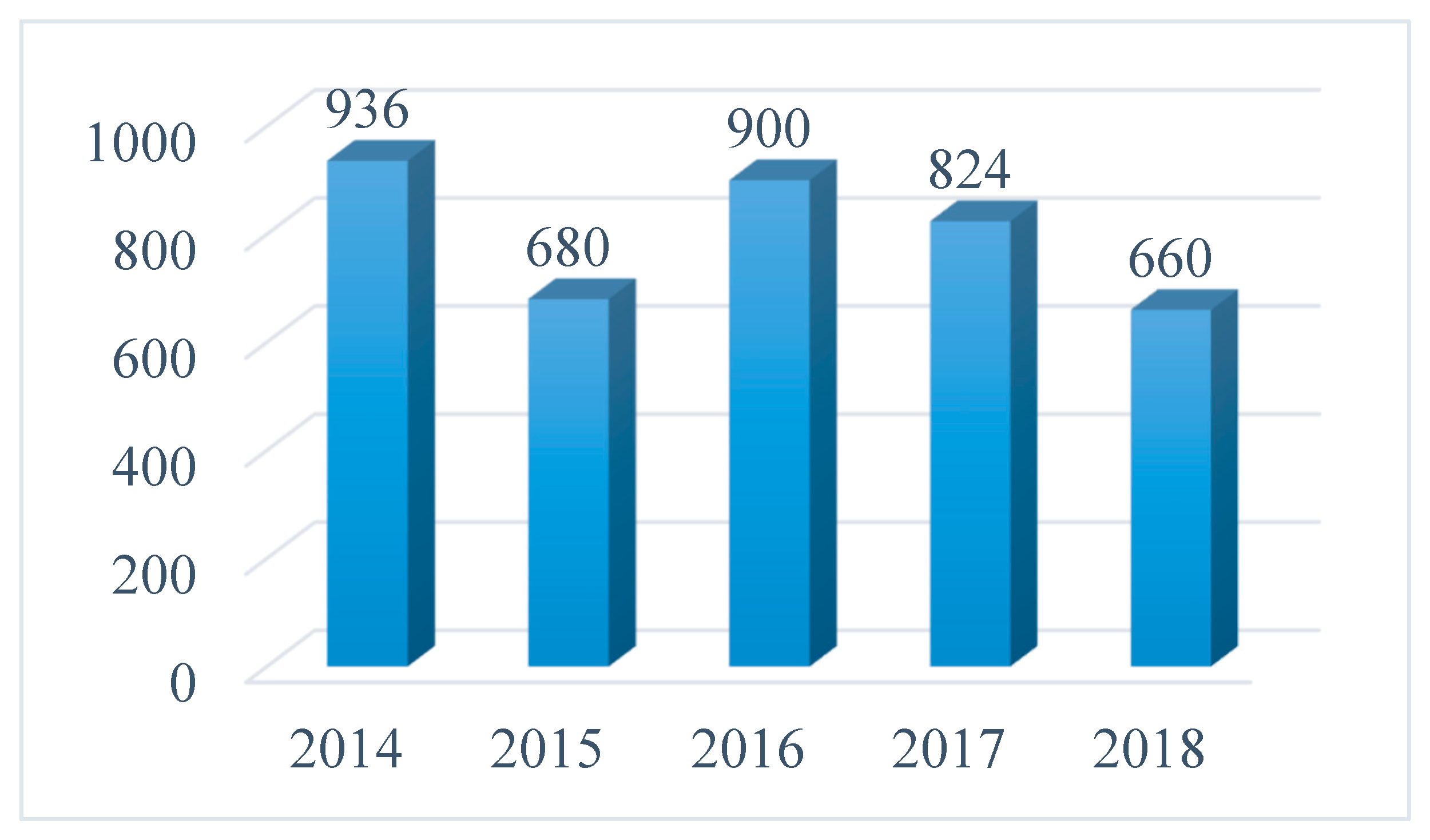
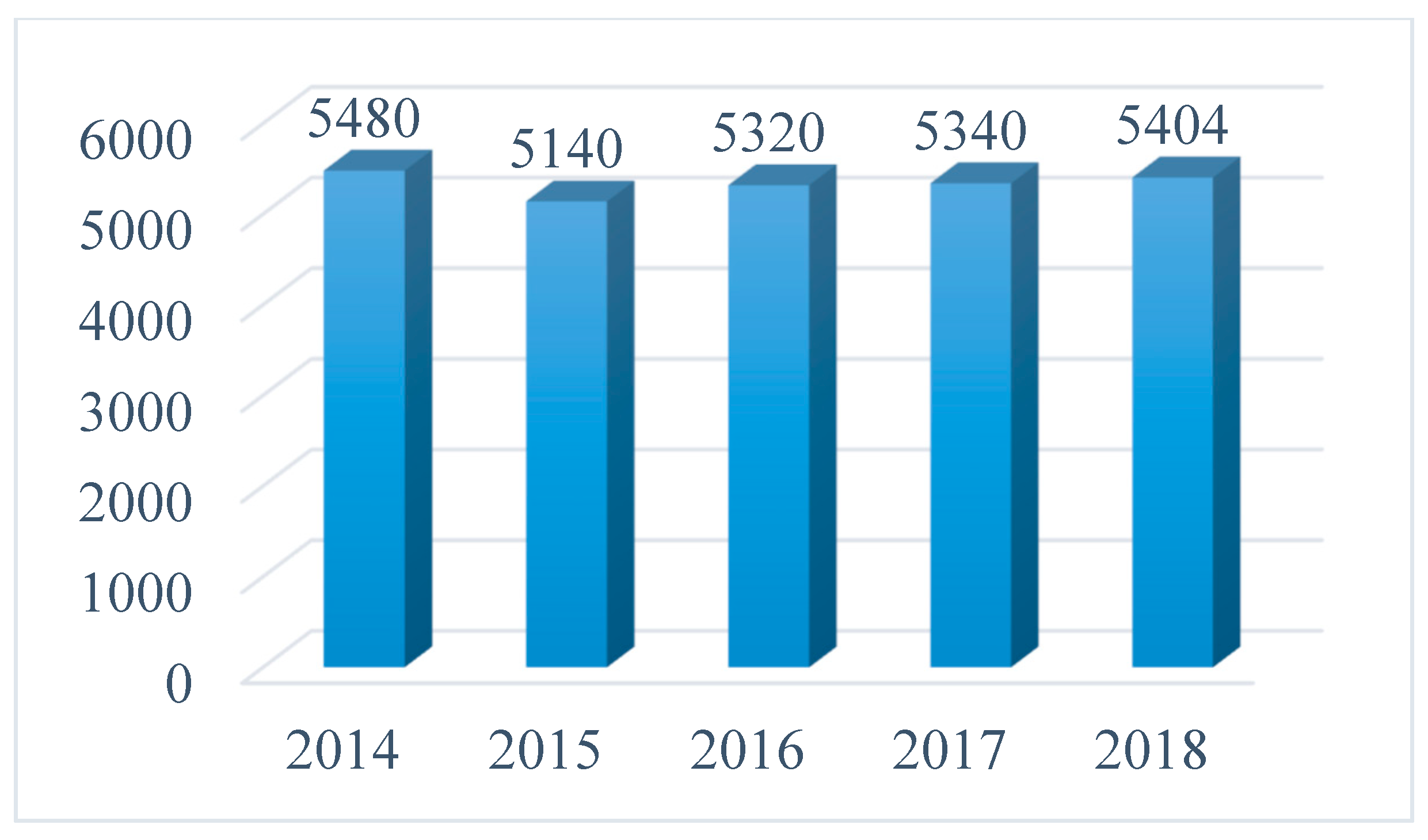

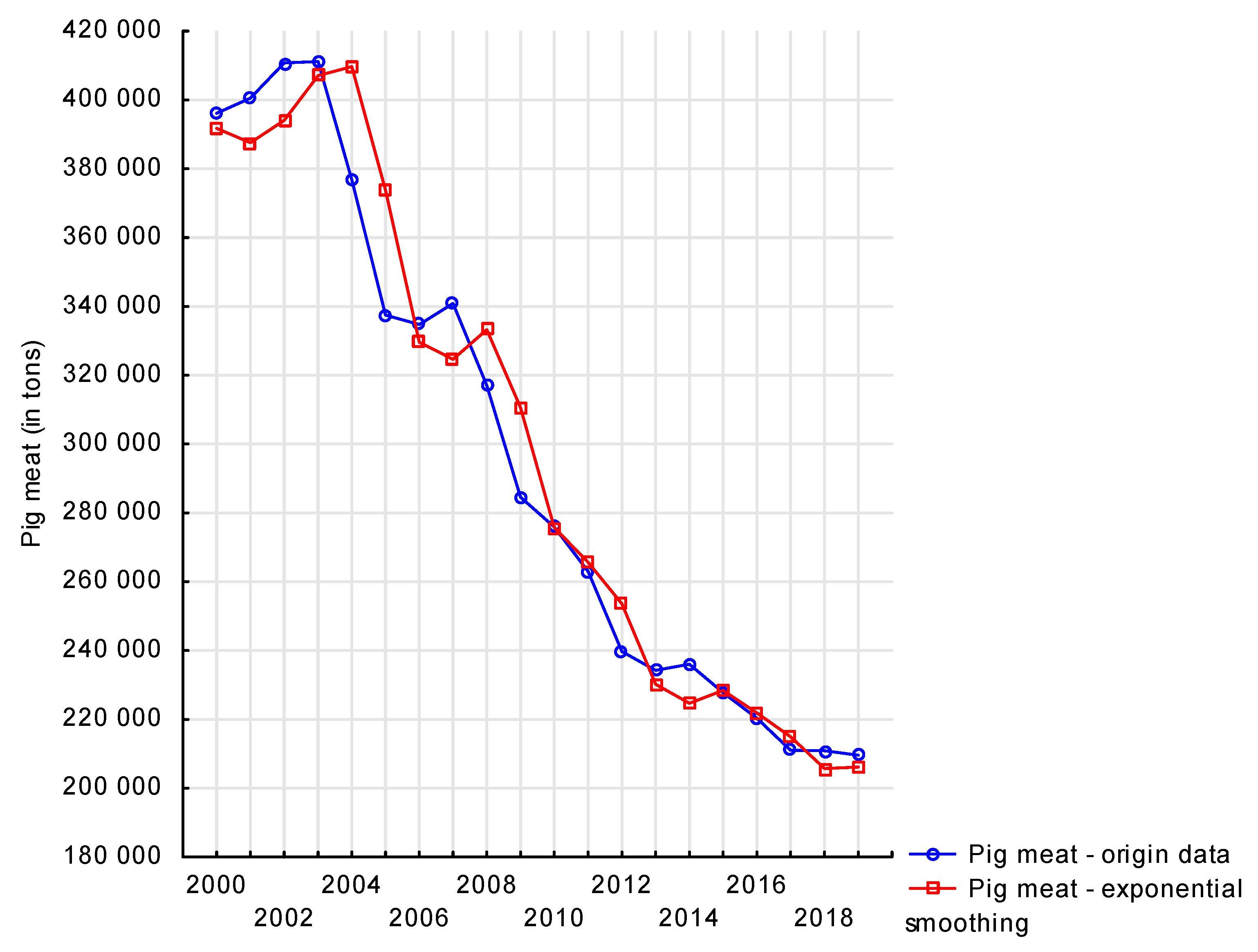
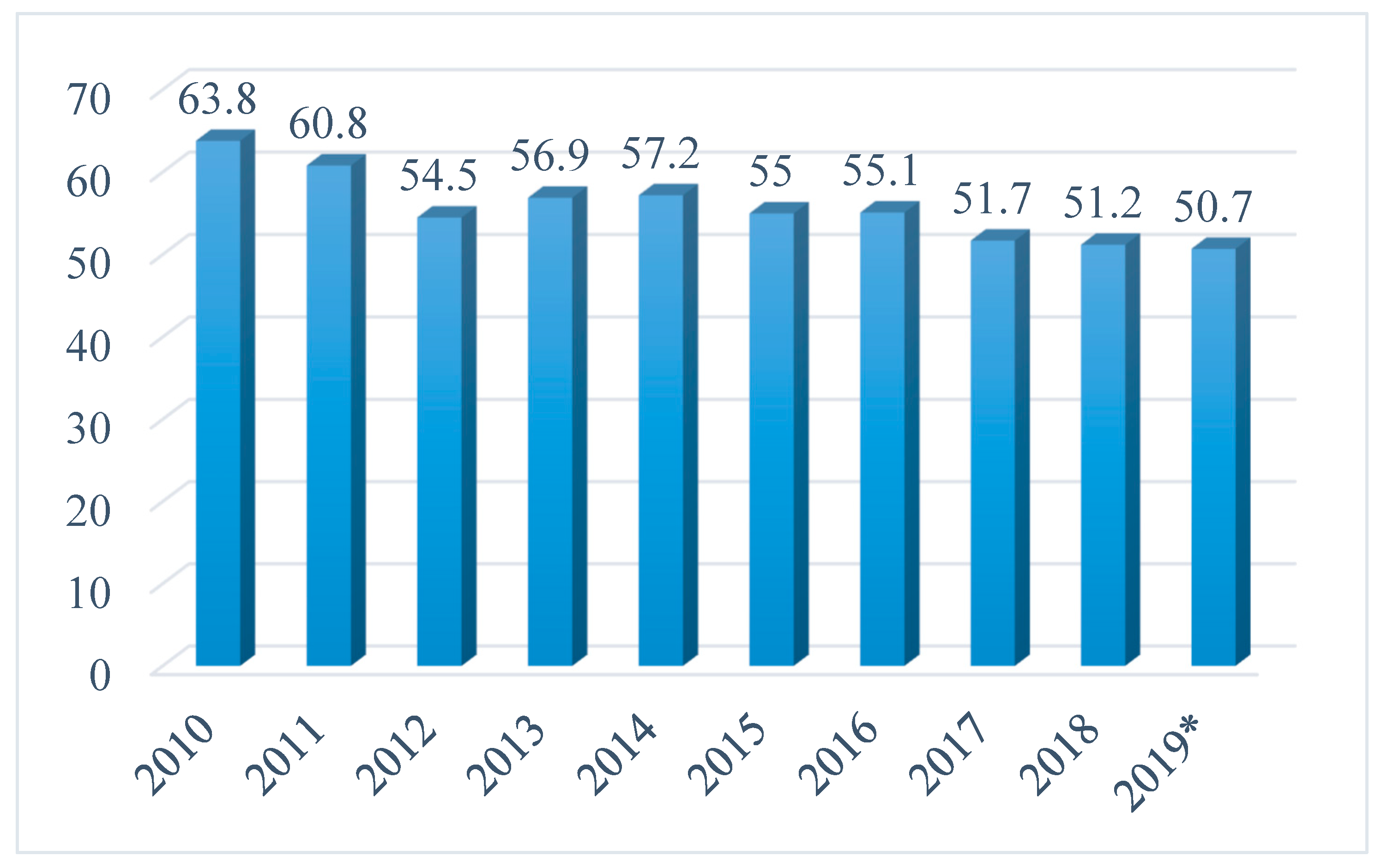
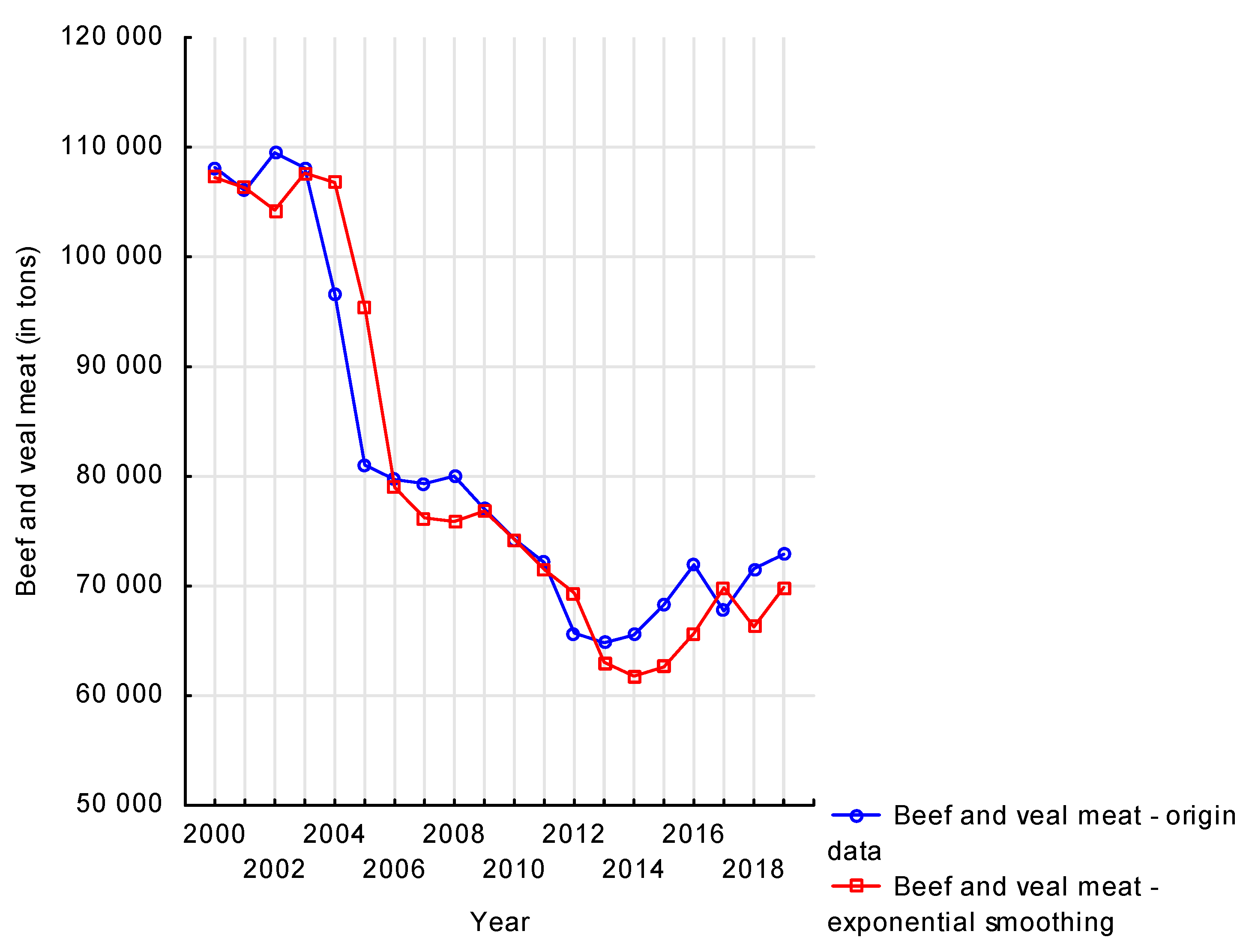
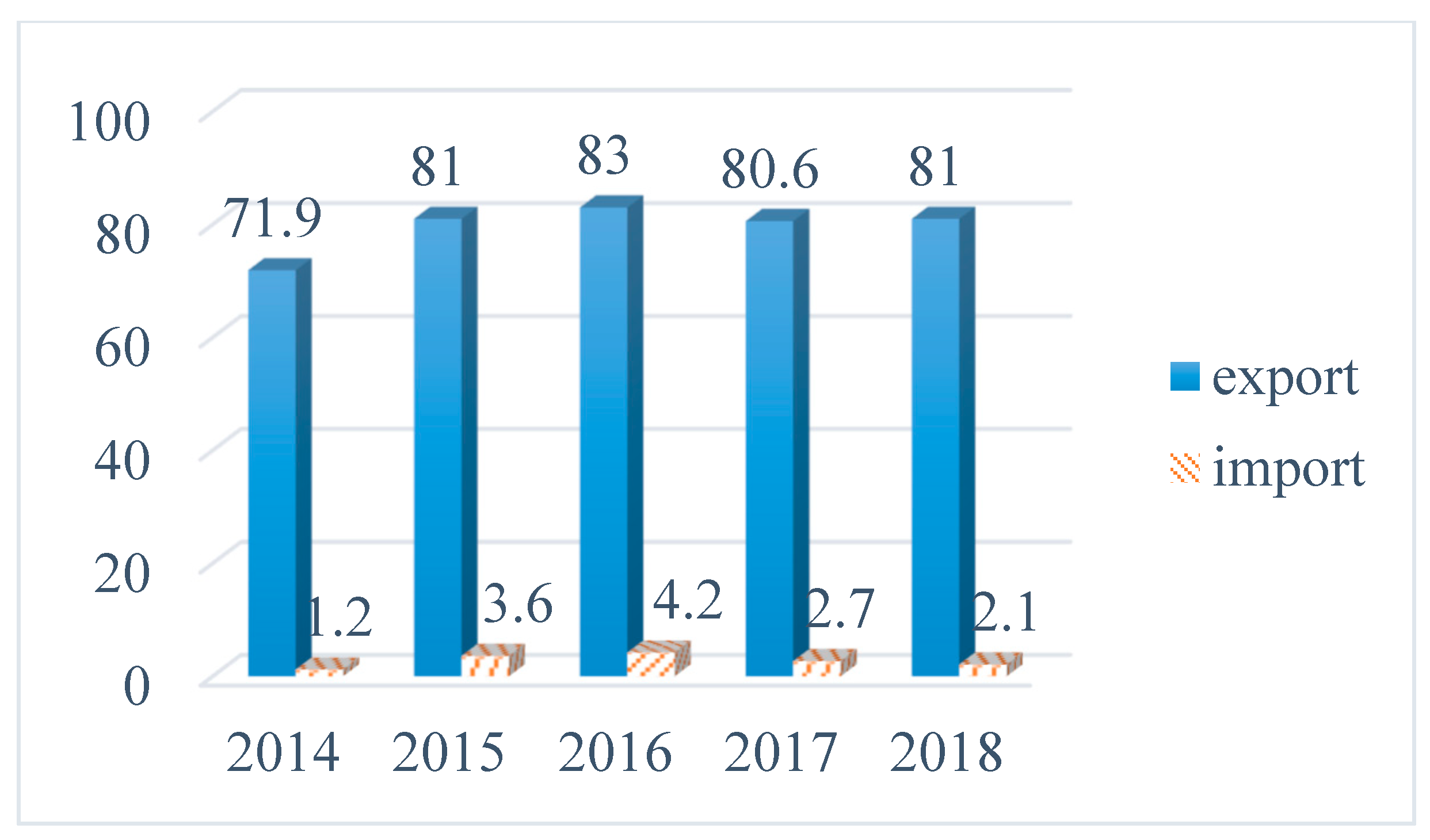
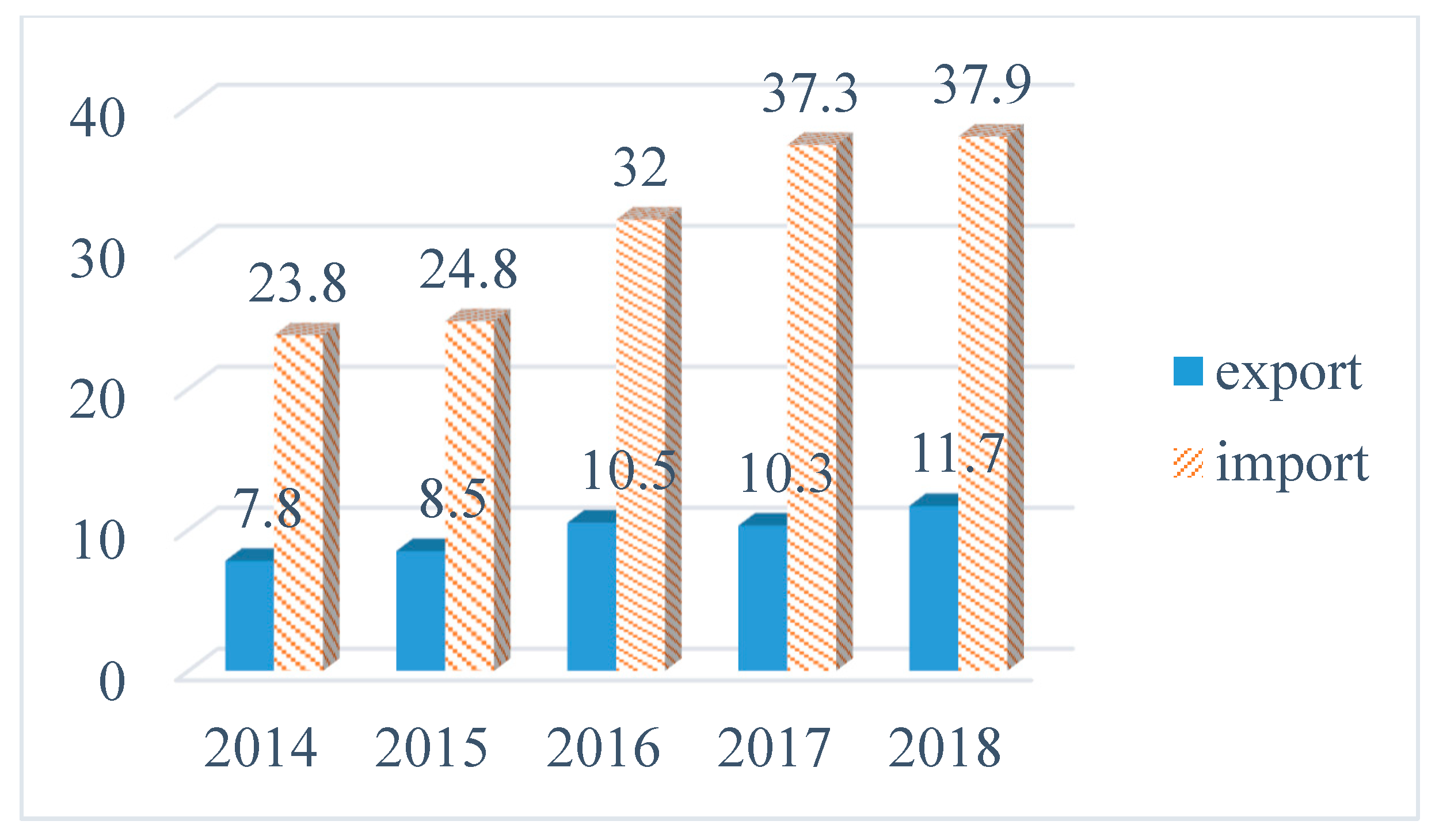
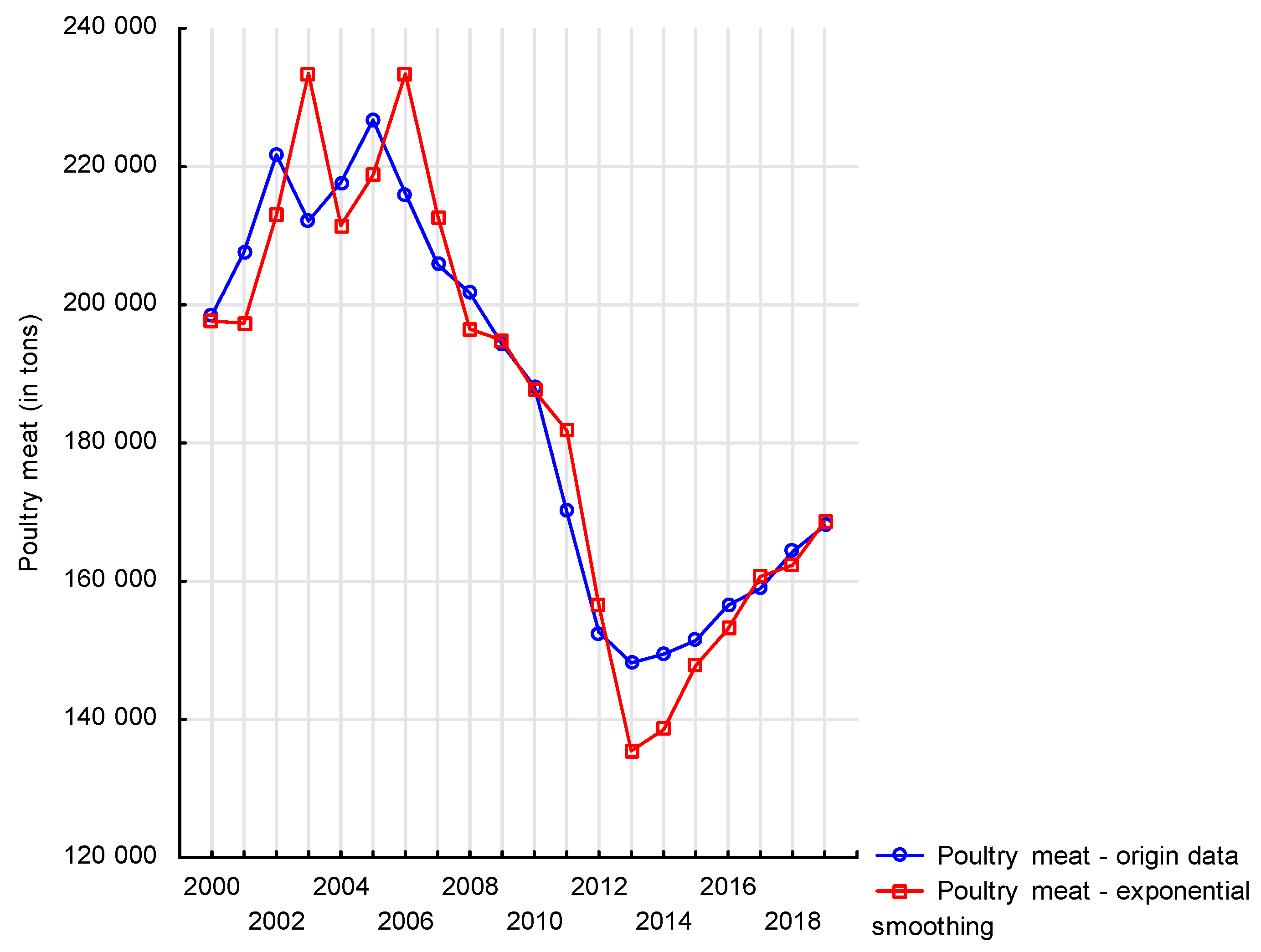
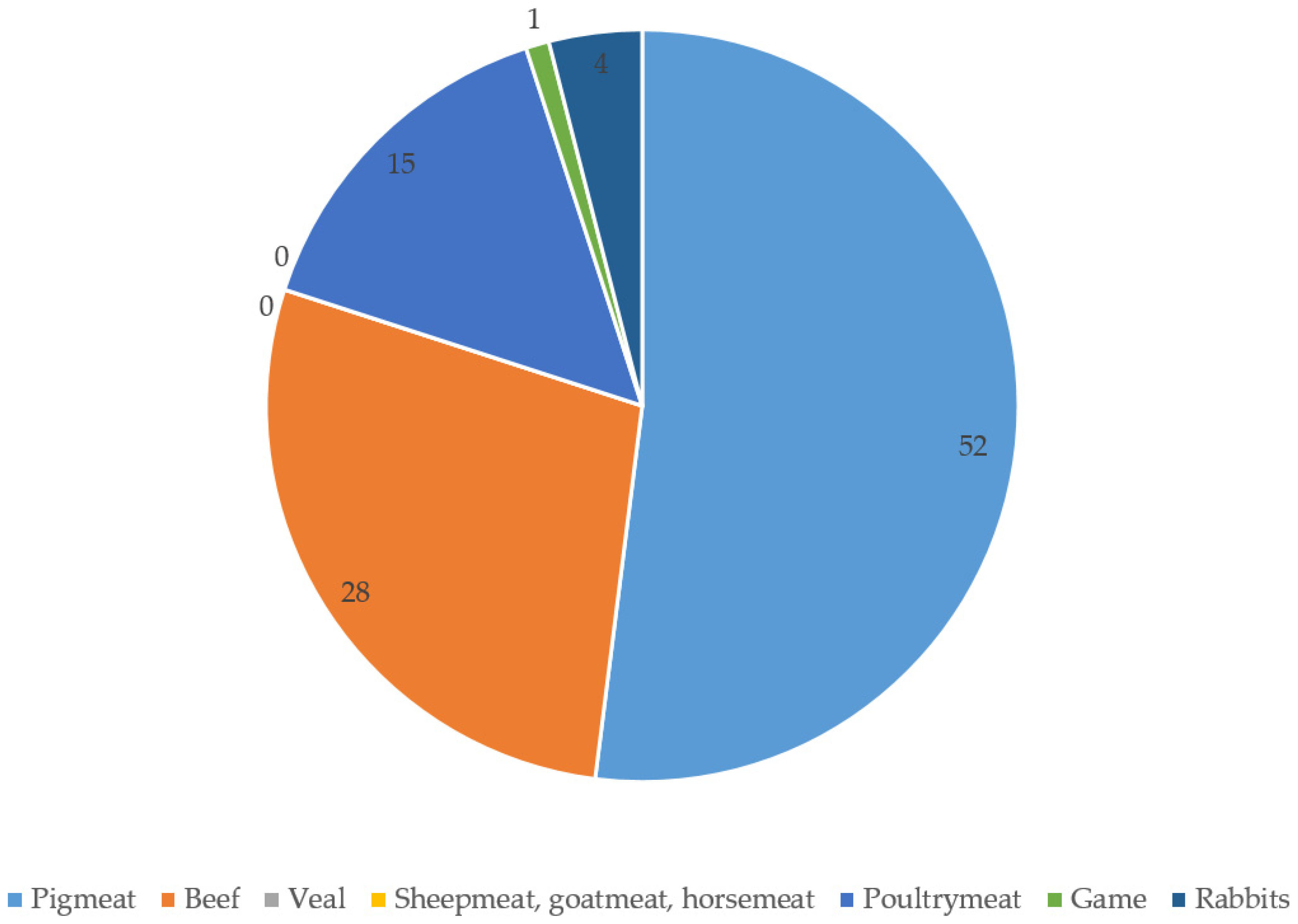
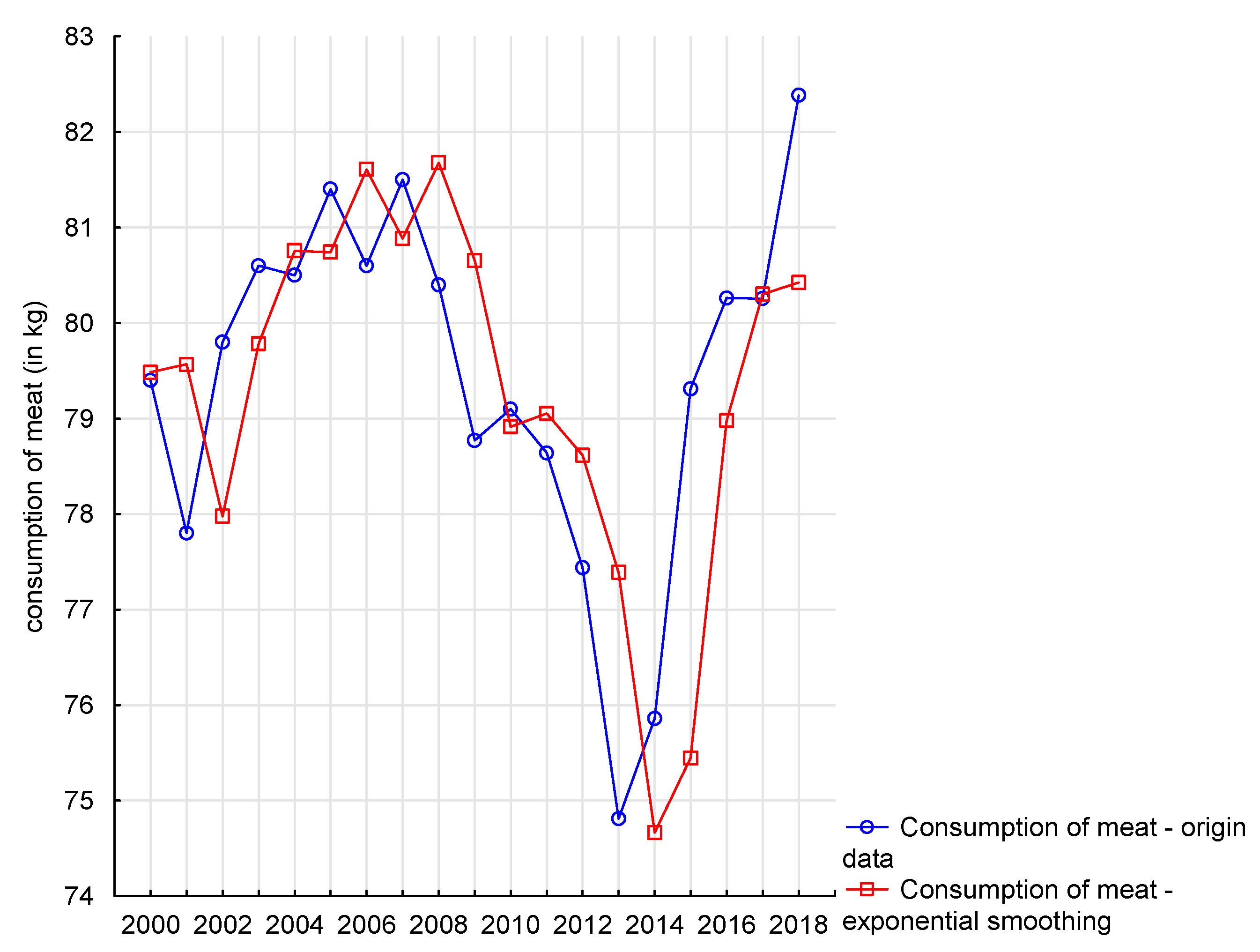
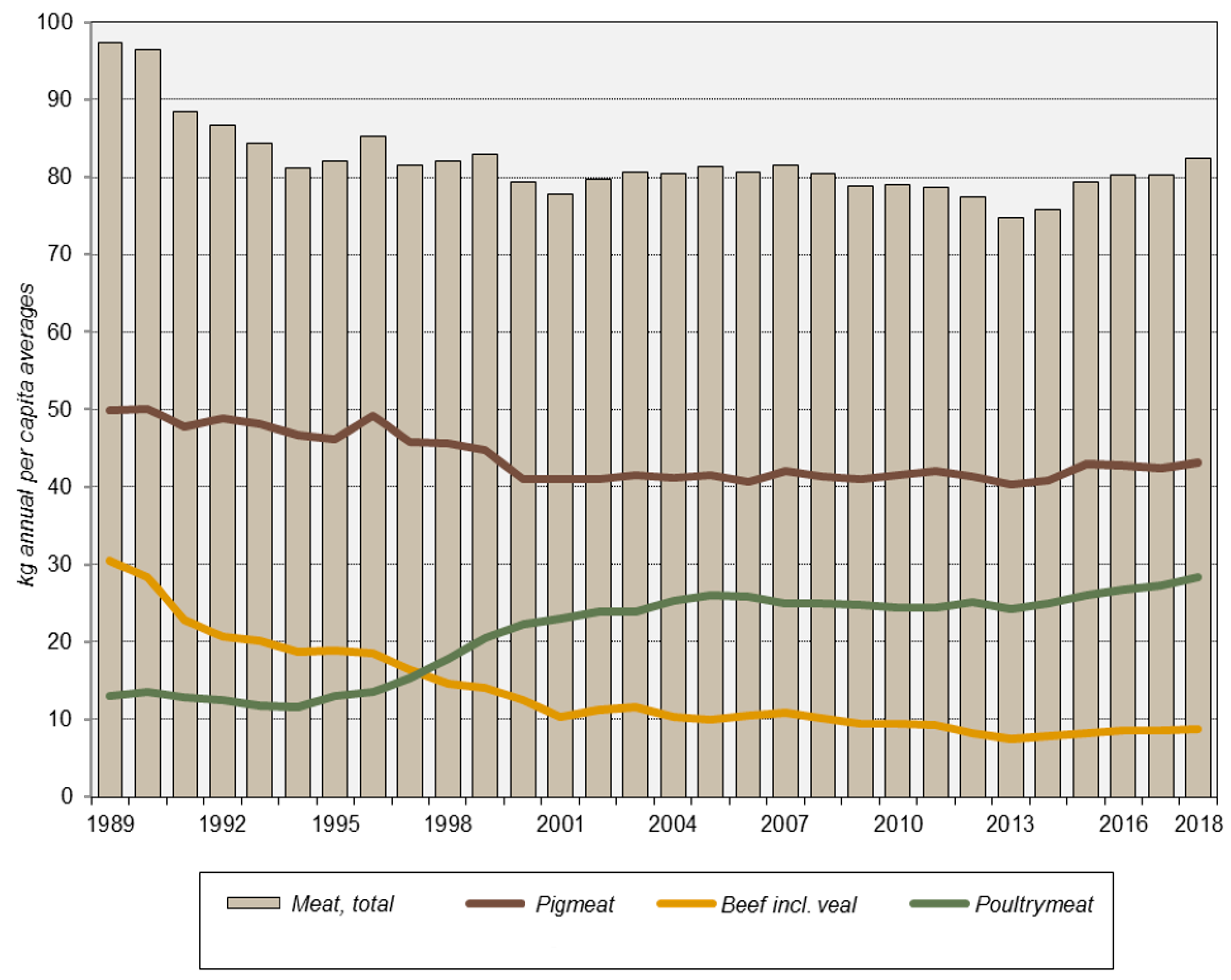
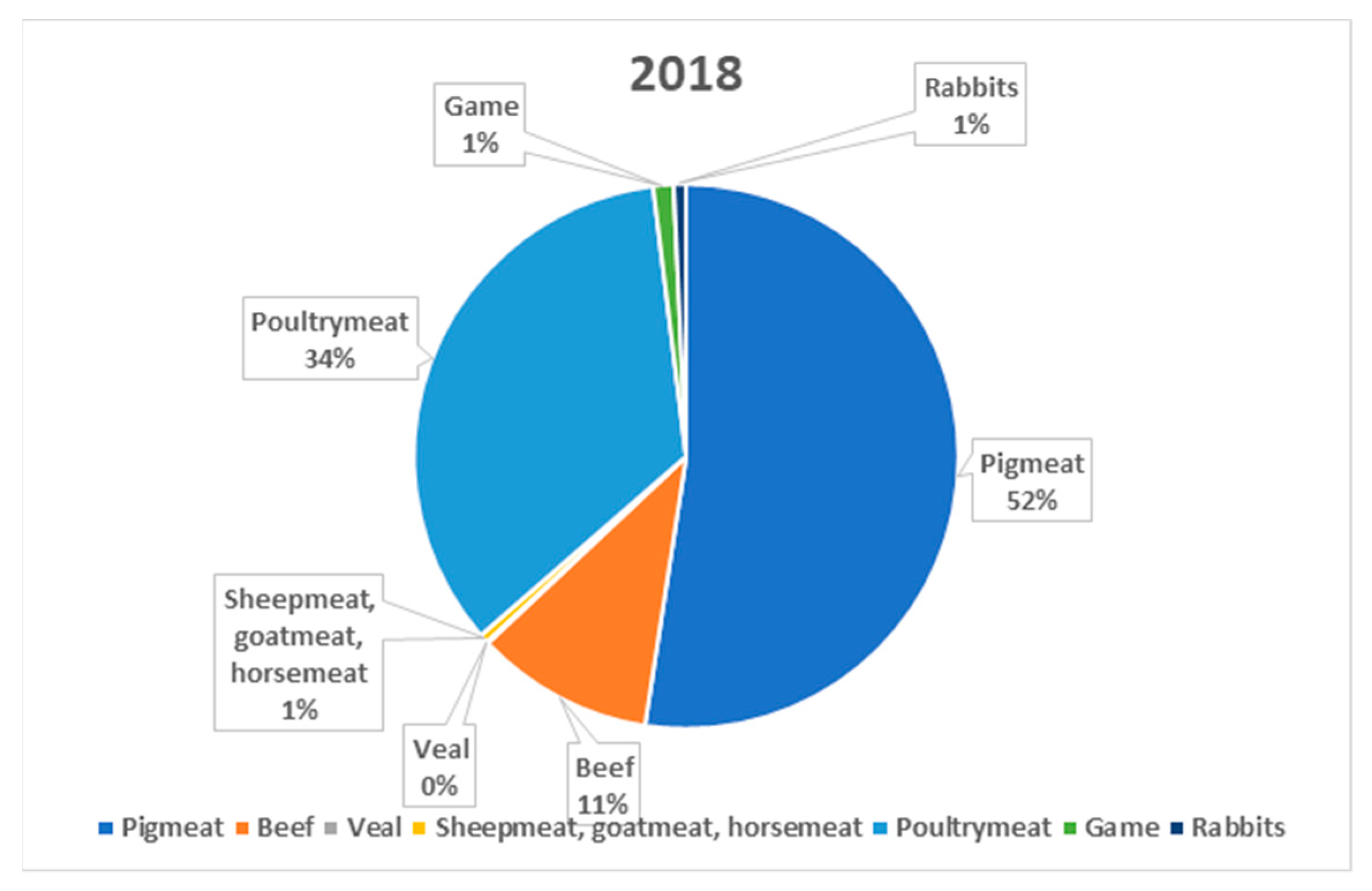
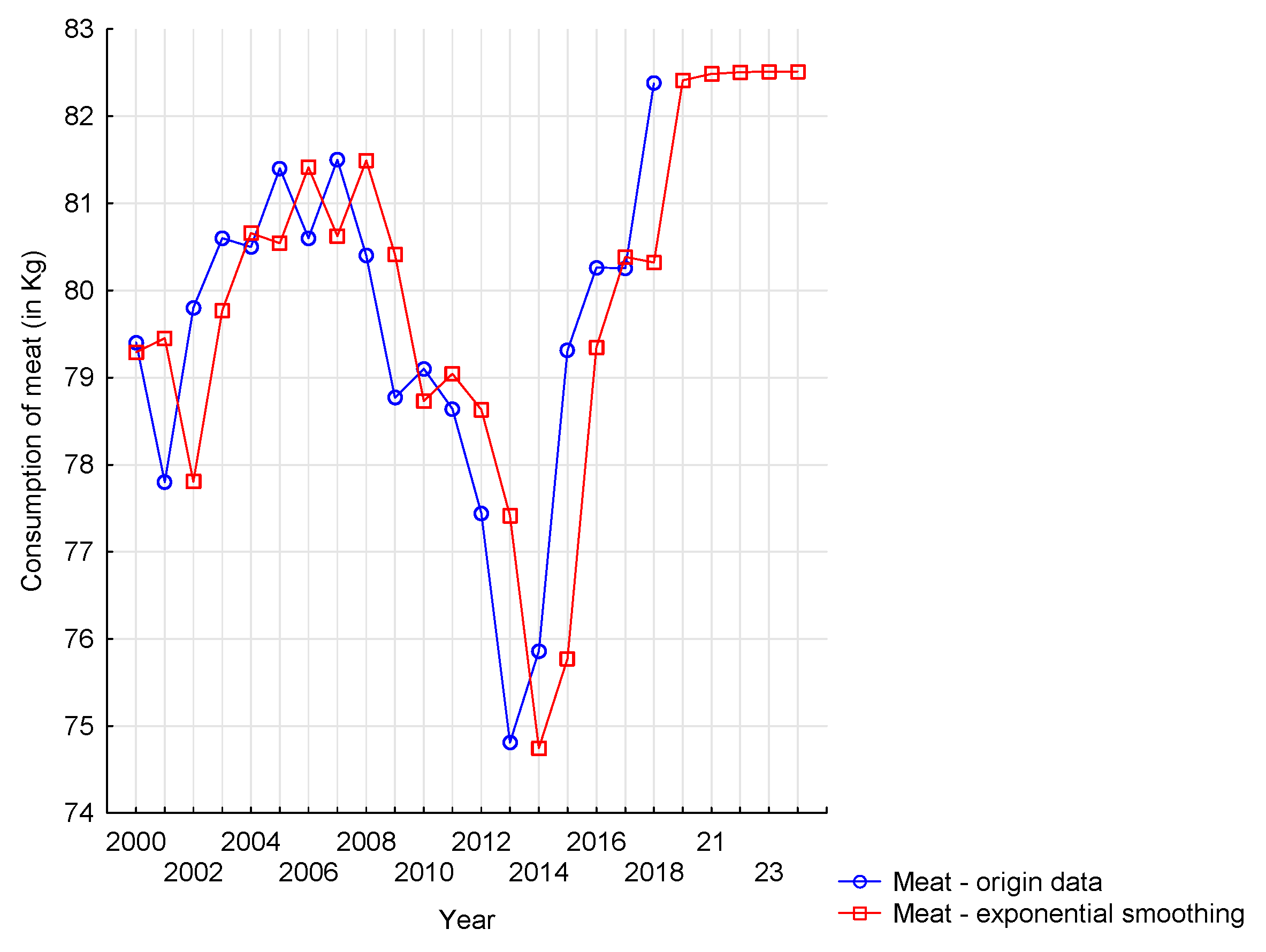
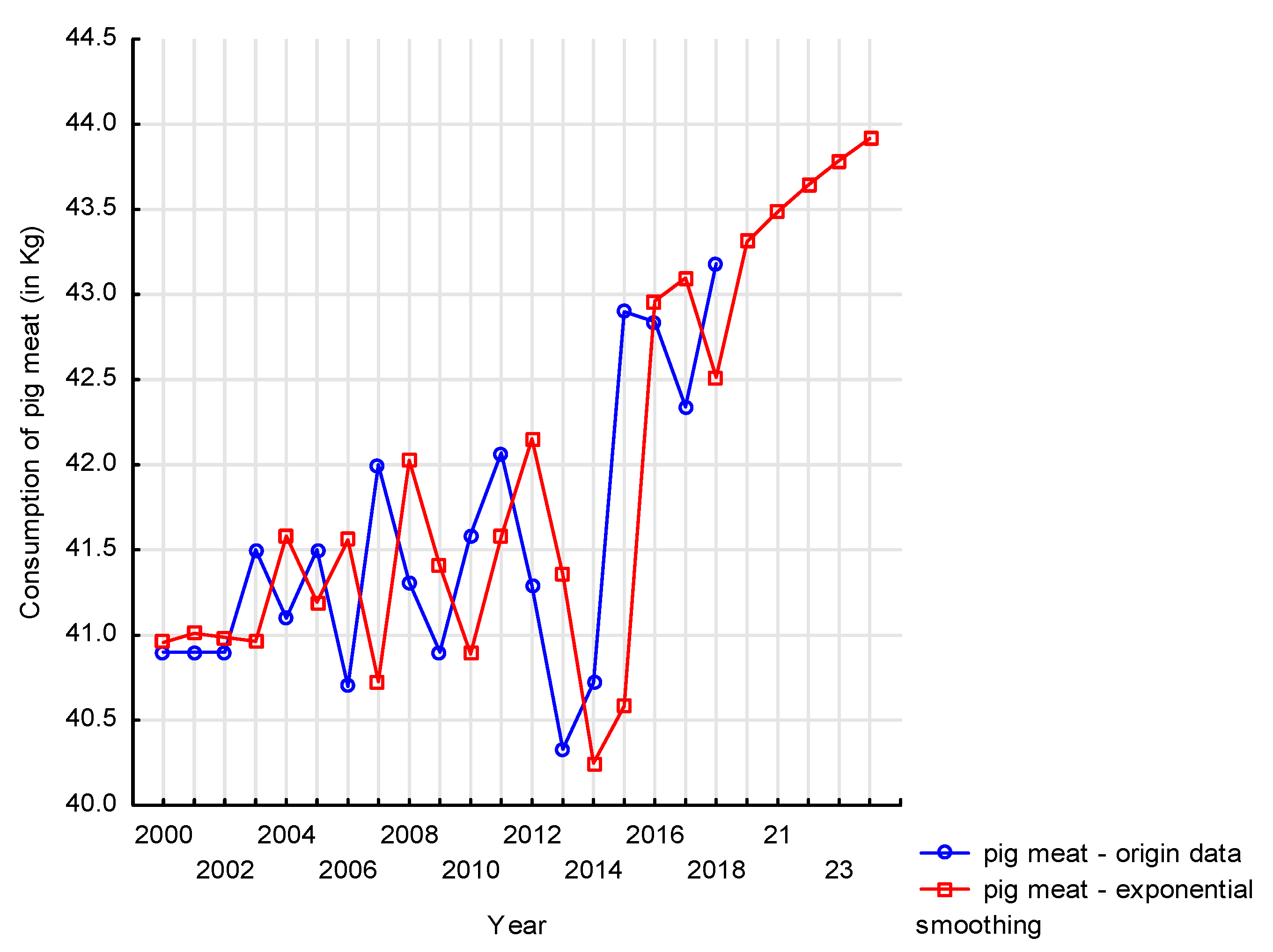
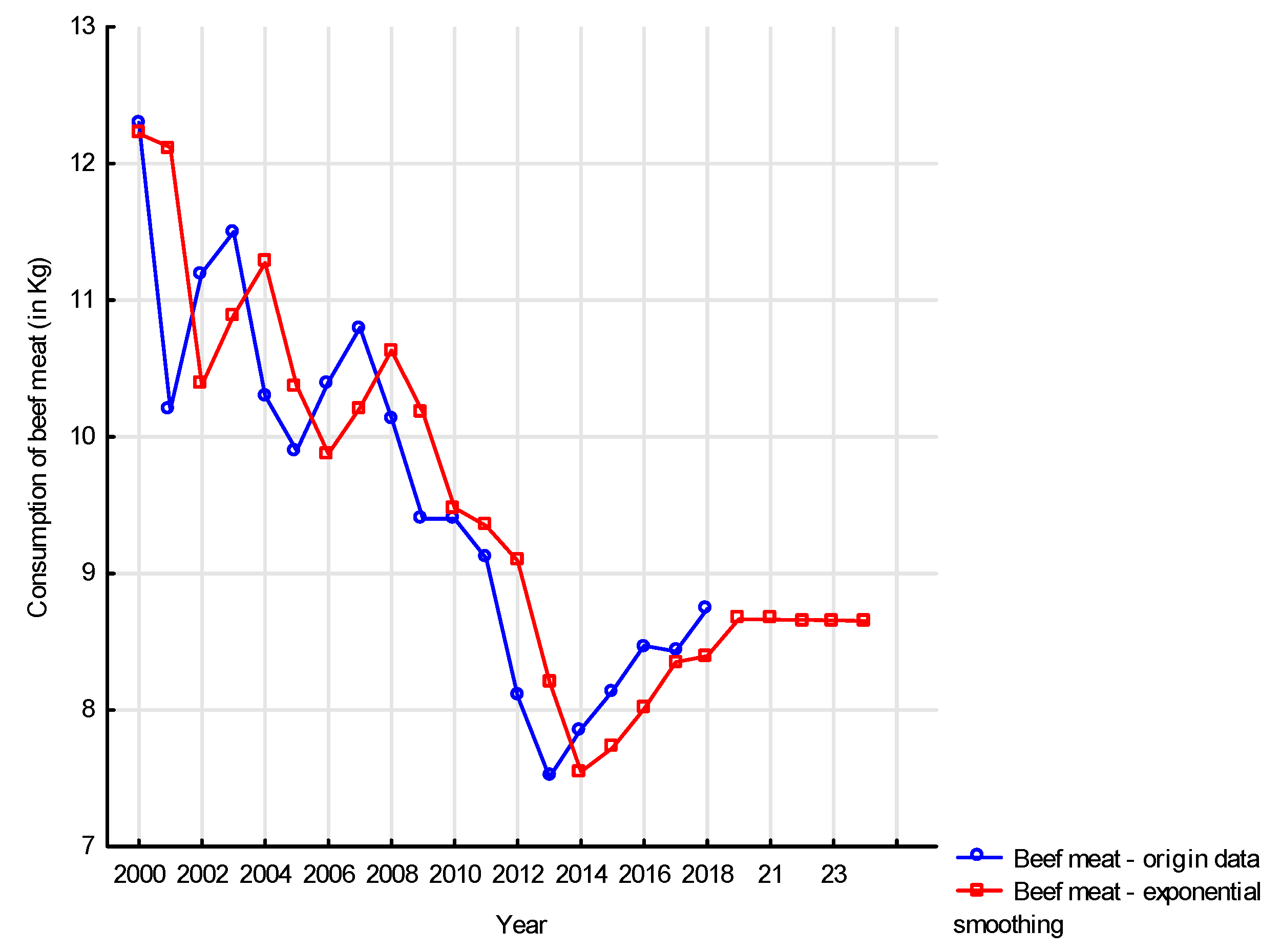
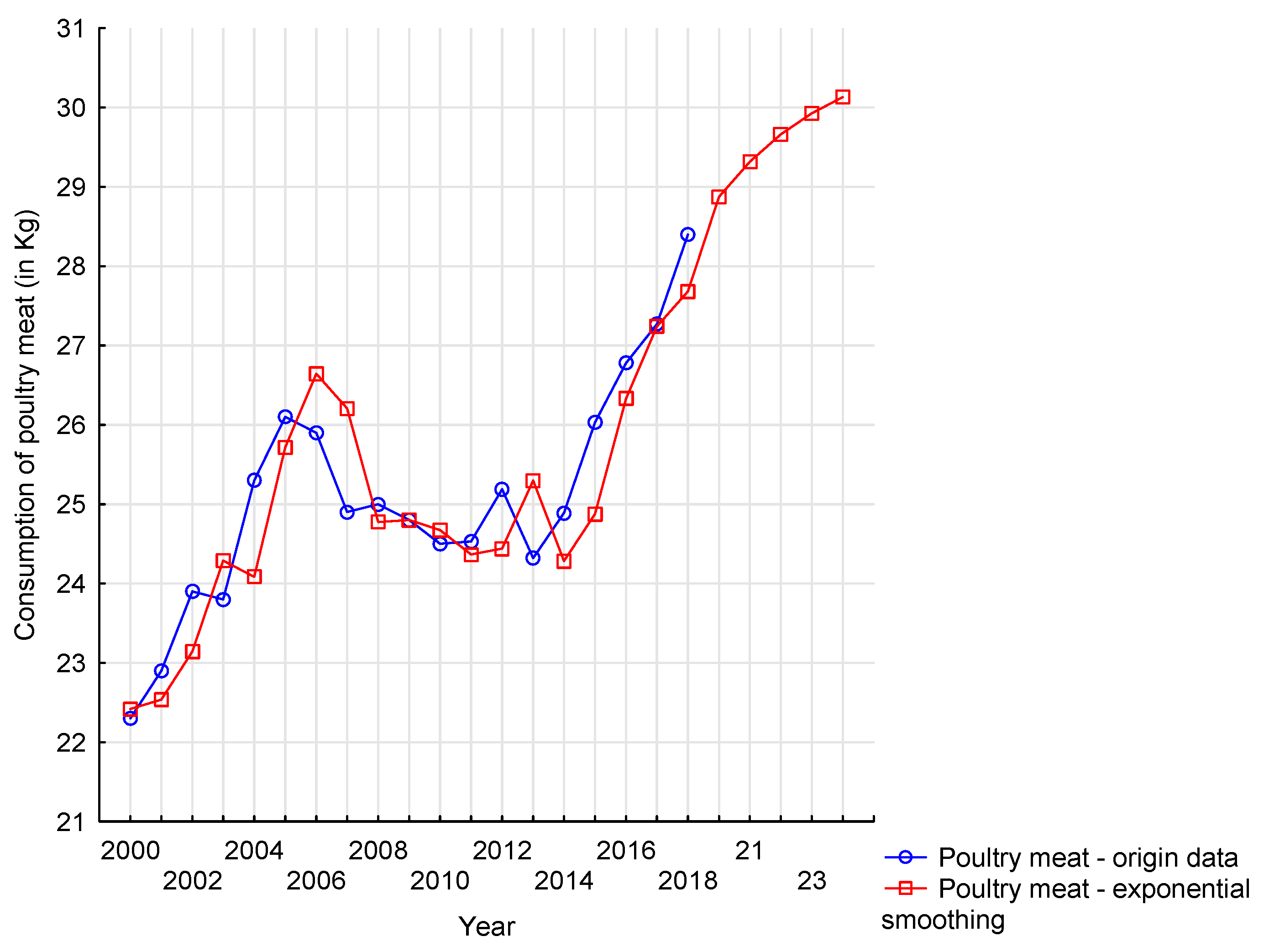
| Production in Tones | Share of Meat Production | |
|---|---|---|
| Pig meat production | 210,910 | 47.3 |
| Beef and veal meat production | 71,579 | 16 |
| Poultry meat production | 164,261 | 36.7 |
| Other meat | 260 | 0 |
| In total | 447,010 | 100 |
| Variable | Pig Meat Production | Beef and Veal Meat Production | Poultry Production |
|---|---|---|---|
| Pig meat production | 1.000000 | 0.754792 | −0.107706 |
| Beef and veal production | 0.754792 | 1.000000 | −0.066815 |
| Poultry production | −0.107706 | −0.066815 | 1.000000 |
| Price of Pork | Price of Beef | Consumption of Pork | Consumption of Beef | |
|---|---|---|---|---|
| Price of pork | 1 | |||
| Price of beef | 0.888 | 1 | ||
| Consumption of pork | 0.227 | −0.035 | 1 | |
| Consumption of beef | −0.909 | −0.735 | −0.014 | 1 |
| Parameter | Meat Total | Pork Meat | Beef | Poultry Meat |
|---|---|---|---|---|
| Alpha | 0.9 | 0.9 | 0.8 | 0.85 |
| Gamma | 0.4 | 0.2 | 0.05 | 0.55 |
| Phi | 0.3 | 0.9 | 0.85 | 0.77 |
| M.A.P.E. (%) | 1.49 | 1,56 | 6.02 | 2.22 |
| Prediction | ||||
| 2020 | 82.41 | 43.31 | 8.67 | 28.87 |
| 2021 | 82.48 | 43.49 | 8.67 | 29.32 |
| 2022 | 82.50 | 43.64 | 8.66 | 29.66 |
| 2023 | 82.51 | 43.79 | 8.66 | 29.92 |
| 2024 | 82.51 | 43.92 | 8.65 | 30.13 |
Publisher’s Note: MDPI stays neutral with regard to jurisdictional claims in published maps and institutional affiliations. |
© 2021 by the authors. Licensee MDPI, Basel, Switzerland. This article is an open access article distributed under the terms and conditions of the Creative Commons Attribution (CC BY) license (http://creativecommons.org/licenses/by/4.0/).
Share and Cite
Šrédl, K.; Prášilová, M.; Severová, L.; Svoboda, R.; Štěbeták, M. Social and Economic Aspects of Sustainable Development of Livestock Production and Meat Consumption in the Czech Republic. Agriculture 2021, 11, 102. https://doi.org/10.3390/agriculture11020102
Šrédl K, Prášilová M, Severová L, Svoboda R, Štěbeták M. Social and Economic Aspects of Sustainable Development of Livestock Production and Meat Consumption in the Czech Republic. Agriculture. 2021; 11(2):102. https://doi.org/10.3390/agriculture11020102
Chicago/Turabian StyleŠrédl, Karel, Marie Prášilová, Lucie Severová, Roman Svoboda, and Michal Štěbeták. 2021. "Social and Economic Aspects of Sustainable Development of Livestock Production and Meat Consumption in the Czech Republic" Agriculture 11, no. 2: 102. https://doi.org/10.3390/agriculture11020102
APA StyleŠrédl, K., Prášilová, M., Severová, L., Svoboda, R., & Štěbeták, M. (2021). Social and Economic Aspects of Sustainable Development of Livestock Production and Meat Consumption in the Czech Republic. Agriculture, 11(2), 102. https://doi.org/10.3390/agriculture11020102






